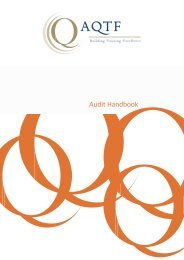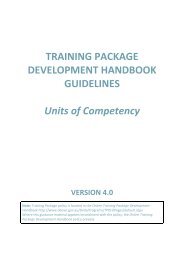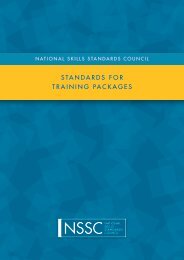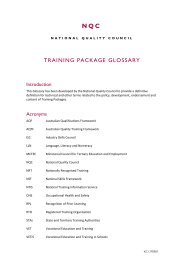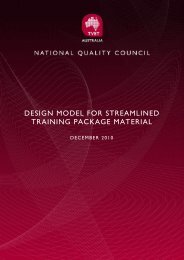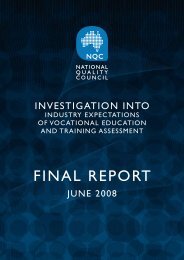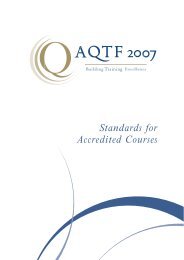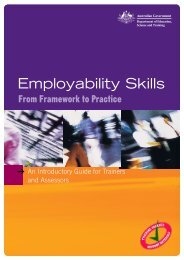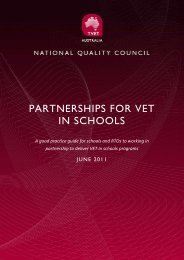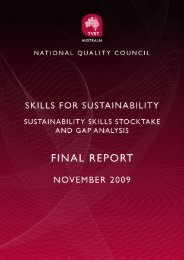VET Products for the 21st Century - National Skills Standards Council
VET Products for the 21st Century - National Skills Standards Council
VET Products for the 21st Century - National Skills Standards Council
Create successful ePaper yourself
Turn your PDF publications into a flip-book with our unique Google optimized e-Paper software.
large body of existing units of competency fromaccredited courses, including <strong>for</strong> preparatoryqualifications, to support knowledge components.Currently only Training Packages units ofcompetency may be used by accredited coursesand not vice versa, but <strong>the</strong>re are cases where suchcomponents have been mainstreamed during <strong>the</strong>review or continuous improvement processes.Comment was also made about <strong>the</strong> significantamount of public funds used to develop accreditedcourses and that making those that are crowncopyright nationally accessible would be a moreeffective and efficient use of <strong>the</strong>se resources.RecommendationsThat <strong>the</strong> NQC:16. Simplify and streamline <strong>the</strong> content of Training Packages by separating <strong>the</strong> per<strong>for</strong>mance standards in unitsof competence from guidance and supporting in<strong>for</strong>mation <strong>for</strong> RTOs with <strong>the</strong> following components subjectto national endorsement:• Units of competence (required knowledge and skills, ie, title, elements, per<strong>for</strong>mance criteria, etc)• Qualifications & Occupational/Foundation outcomes• Qualification packaging rules• Assessment Requirements• Credit Arrangements17. Restructure and streamline Training Package content by:• simplifying <strong>the</strong> endorsed components – by reducing <strong>the</strong> level of detail included in <strong>the</strong> endorsedTraining Packages, particularly <strong>the</strong> level of specification in <strong>the</strong> competency standards;• expanding non-endorsed components – much of <strong>the</strong> detail and specification removed from endorsedcomponents can instead be included in user guides where more flexible structural and <strong>for</strong>mattingoptions mean that material can be edited and packaged in a way that makes <strong>the</strong>se documents morereadable and useable;• eliminating unnecessary in<strong>for</strong>mation and consolidating repetitive material;• continuing to consolidate <strong>the</strong> units of competence that cover <strong>the</strong> same or similar areas of knowledgeand skill; and• dividing Packages into more fit-<strong>for</strong>-purpose components focused on <strong>the</strong> needs of industry andemployers on <strong>the</strong> one hand and providers on <strong>the</strong> o<strong>the</strong>r.18. Develop a quality assurance process <strong>for</strong> non-endorsed components of Training Packages.19. Reaffirm that course accrediting bodies (RCABs) have <strong>the</strong> capacity to accept/approve courses where <strong>the</strong>outcomes identified by RTOs and enterprises are not available in endorsed Training Packages.20. Make it mandatory <strong>for</strong> crown copyright state accredited courses to be publically available on <strong>the</strong> NTIS. 1111Refer to page 9 <strong>for</strong> additional resolution from MCVTE<strong>VET</strong> PRODUCTS FOR THE 21 ST CENTURY - 19



